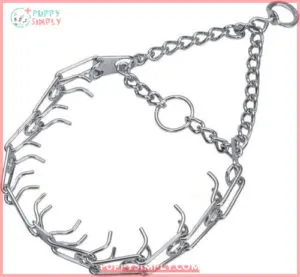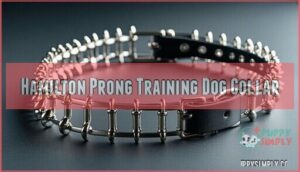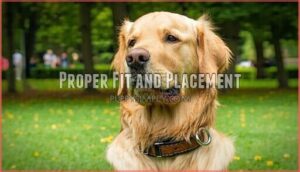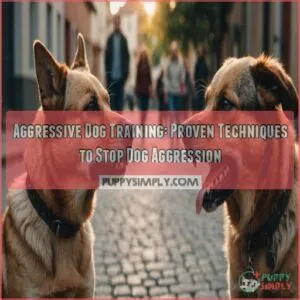This site is supported by our readers. We may earn a commission, at no cost to you, if you purchase through links.
 When you’re searching for the best prong collar for dogs, you’ll want to focus on quality brands like Herm Sprenger, which professional trainers consistently recommend for good reason.
When you’re searching for the best prong collar for dogs, you’ll want to focus on quality brands like Herm Sprenger, which professional trainers consistently recommend for good reason.
These collars work by applying gentle, even pressure around your dog’s neck when they pull, mimicking how a mother dog corrects her puppies.
The key is proper sizing—the collar should fit snugly high on the neck, just behind the ears.
Stainless steel options offer durability and easy cleaning, while proper introduction and positive reinforcement make all the difference in training success.
However, choosing the right material, understanding proper placement, and knowing when these tools aren’t appropriate can mean the difference between transformation and frustration.
Table Of Contents
- Key Takeaways
- Should I Use a Training Collar?
- Buyer’s Guide – Choosing The Best Prong Collar for Dogs
- What is a Pinch Collar?
- Buyer’s Guide: How to Choose The Best Prong Collar for Your Dog
- Herm Sprenger Dog Prong Collar
- Hamilton Prong Training Dog Collar
- How to Properly Use a Prong Collar for Dog Training
- Frequently Asked Questions (FAQs)
- Do vets recommend prong collars for dogs?
- What is the best collar for a dog that stops pulling?
- What is the difference between a prong collar and a choke collar?
- How do I know if my dog needs a prong collar?
- Are prong collars safe to use on puppies?
- How often should I adjust the size of my dog’s prong collar?
- Are there any risks associated with using a prong collar on my dog?
- How long can dogs wear prong collars daily?
- Can prong collars cause permanent neck damage?
- What age should puppies start using prong collars?
- Conclusion
Key Takeaways
- Choose quality materials and proper sizing – You’ll want stainless steel or alloy steel prong collars from reputable brands like Herm Sprenger, with the collar fitting snugly high on your dog’s neck just behind the ears.
- Don’t use prong collars on small dogs or puppies – You shouldn’t use these training tools on dogs under 30 pounds or puppies under 6 months old, as their delicate necks can’t handle the pressure safely.
- Combine prong collars with positive reinforcement – You’ll get better results when you pair gentle corrections with treats, praise, and rewards rather than using the collar as punishment alone.
- Limit use to training sessions only – You should only use prong collars during 15-30 minute training sessions and remove them immediately afterward – never leave them on for everyday wear or unsupervised time.
Should I Use a Training Collar?
Choosing a dog training collar isn’t a decision to take lightly.
Your dog’s temperament and specific behavioral issues should guide this choice.
Professional guidance proves invaluable when considering prong collars versus collar alternatives like no-pull harnesses.
Training philosophy matters—effective dog training combines tools with positive reinforcement, not punishment alone.
Ethical considerations include your dog’s comfort and safety.
While prong collars can help with pulling, they’re not suitable for every dog.
Small or sensitive dogs need gentler approaches.
A humane dog collar should enhance dog behavior training, not cause distress.
Remember, the best tool is one you’ll use correctly and consistently, with effective dog training as the goal.
Buyer’s Guide – Choosing The Best Prong Collar for Dogs
When you’re shopping for a prong collar, you’ll want to focus on material quality, proper sizing, and safety features that match your dog’s specific needs.
The right collar can make training sessions more effective while keeping your furry friend comfortable and safe.
Features
When choosing your prong collar, you’ll want to focus on five key features.
Prong thickness affects correction intensity – thicker prongs provide gentler feedback. Material durability matters most; stainless steel prong collars outlast cheaper alternatives.
Size adjustability through removable links guarantees proper fit as your dog grows. Buckle security prevents accidental releases during training.
How It Works
With prong collars, the correction mechanism works like your dog’s mom would handle misbehavior. When your pup pulls, the collar applies even pressure around their neck, creating an immediate feedback loop that says "hey, ease up there."
Here’s how the pressure distribution and correction process works:
- Mimicking mother – The prongs simulate a mother dog’s gentle corrective bite
- Immediate feedback – Your dog feels the pinch the moment they pull forward
- Even pressure – Unlike choke collars, prong collars distribute force around the entire neck
- Quick release – Pressure stops instantly when your dog returns to proper position
- Proper sizing makes the correction feel consistent without causing harm
Think of it as having a conversation with your dog through the leash. The pinch collar doesn’t hurt when fitted correctly – it just gets their attention. This dog training collar works because dogs naturally understand pressure-based communication from their pack days.
Many owners also consider durable nylon options for everyday use. For effective correction during prong collar training, the collar should sit high on the neck, just behind the ears, where it’s most sensitive to gentle pressure.
What is a Pinch Collar?
You might wonder if a pinch collar is just another name for a prong collar – and you’d be right.
These training tools use metal prongs that apply gentle pressure around your dog’s neck when they pull, mimicking how a mother dog would correct her puppy with a quick nip.
Just Say No to Pinch Collars for Small Dogs
While prong collars work for larger breeds, they’re a big no for small dogs. Think of it this way: what works for a German Shepherd won’t necessarily work for a Chihuahua.
Studies show up to 30% of dogs using prong collars show physical injury signs, and small dogs face even higher risks. Your toy breed’s delicate neck can’t handle the pressure that larger dogs can manage.
Small Dog Safety becomes critical here because their tracheas are fragile and prone to collapse. Injury Risks include bruising, puncture wounds, and nerve damage that can cause lasting problems.
Many owners find vibration bark collars a gentler alternative. Instead of risking harm with a prong collar, consider Humane Alternatives like no-pull harnesses or head collars.
These Training Methods provide effective control without the Ethical Concerns that come with aversive tools. A safe prong collar simply doesn’t exist for small breeds – the physics don’t work in their favor.
Your pup deserves dog training that builds trust, not fear. Choose a dog training collar that matches your pet’s size and needs.
Would I Recommend a Pinch Collar to You?
My honest answer? It depends on your training philosophy and dog temperament.
A prong collar can be an effective dog training tool when used correctly, but it’s not for everyone.
If you’re an experienced owner comfortable with proper techniques, it might work well for strong pullers.
However, many trainers now favor humane alternatives like no-pull harnesses or head halters for ethical considerations.
These collar alternatives often prove just as effective without potential risks.
Before choosing any dog training collar, consider your comfort level, your dog’s sensitivity, and whether you have access to professional guidance.
Sometimes the most effective dog collar is simply the one you’ll use consistently and correctly, which can be a key factor in successful dog training.
Buyer’s Guide: How to Choose The Best Prong Collar for Your Dog
Choosing the right prong collar for your dog depends on several key factors that’ll make training safer and more effective.
You’ll want to take into account the material, size, weight, and specific features that match your dog’s needs and temperament.
Alloy Steel Dog Prong Collars
Most dog trainers recommend alloy steel prong collars for their perfect balance of alloy strength and lightweight design.
You’ll appreciate the rust resistance that keeps your dog training collar looking new.
These collars offer exceptional prong durability compared to basic stainless steel prong options, making them ideal for small breeds needing gentle yet effective dog training without bulk.
For smaller breeds, consider a collar with micro prongs for a more comfortable fit.
Stainless Steel Dog Prong Collars
Stainless steel prong collars offer superior durability factors and rust resistance compared to other materials.
Their hypoallergenic properties make them ideal for sensitive dogs, while polishing methods guarantee smooth surfaces.
When selecting your stainless steel prong collar, consider link thickness for appropriate correction levels.
These dog training collars withstand harsh conditions while maintaining effectiveness, and choosing the right prong collar size is crucial for maximum results.
These collars offer gentle, evenly dispersed pressure when properly used, providing a safe and effective training method with evenly dispersed pressure.
Nickel Dog Prong Collars
With nickel-plated prong collars, you’re getting solid value for your training investment.
These collars balance affordability with performance, though they require attention to detail.
Here’s what matters most:
- Nickel allergies – Check your dog’s skin sensitivity before use
- Corrosion resistance – Decent protection but not bulletproof like stainless steel
- Coating options – Nickel plating provides shine and durability concerns
- Cost analysis – Budget-friendly at $50-$80 range
These dog training collars work well for most situations, delivering reliable pinch collar functionality without breaking the bank.
You can find various nickel prong options online.
Helps in Training Your Dog
Most trainers agree that prong collars offer effective corrections for stubborn pullers when traditional methods fail.
The immediate feedback helps with leash reactivity and behavior modification, making dog training sessions more productive.
You’ll see training benefits when you pair reinforcement with gentle corrections, creating clear communication between you and your pup during obedience work.
Helps to Reduce Biting
Beyond training basics, a quality prong collar can address biting behaviors through controlled pressure and immediate feedback.
When your dog exhibits aggressive tendencies, the collar’s design mimics natural corrections that redirect unwanted responses.
Here’s how prong collars help with bite inhibition:
- Puppy Biting Control – Gentle pressure teaches bite inhibition during critical socialization periods
- Redirecting Bites – Immediate feedback interrupts the bite sequence, allowing for positive redirection
- Aggression Training – Consistent correction paired with rewards modifies reactive behaviors safely
The key lies in proper timing and technique.
A well-fitted dog training collar provides the communication bridge between you and your pet during aggression training sessions.
Remember, this pinch collar works best when combined with safe socialization practices and positive reinforcement methods for lasting dog behavior modification.
Corrective Behavior
Prong collars excel at behavior correction by providing consistent feedback that mimics natural pack mentality.
When your dog exhibits leash reactivity or inherent aggression, the collar delivers humane corrections that communicate boundaries clearly.
This approach works particularly well for breed predisposition issues, helping modify problematic behaviors through immediate, gentle pressure that dogs understand instinctively.
| Behavior Issue | Prong Collar Response | Training Outcome |
|---|---|---|
| Pulling/Lunging | Immediate pressure feedback | Calmer walking behavior |
| Dominance displays | Consistent correction timing | Improved respect levels |
| Aggressive reactions | Clear boundary communication | Reduced reactive episodes |
Size
Getting the right collar size is essential for your dog’s comfort and safety.
Start with an accurate neck measurement using a soft tape measure, then add about two inches for proper fit.
Most quality collars feature adjustable links that let you customize the size perfectly – simply add or remove individual links as needed.
Consider breed considerations when sizing, as bulldogs need wider collars while greyhounds require narrower ones.
For growing puppies, choose sizing alternatives that accommodate puppy growth without frequent replacements.
Remember, a properly fitted dog collar should sit snugly but allow two fingers underneath for comfort.
Weight
The right collar weight makes all the difference in your dog’s comfort and training success.
Lighter materials work better for smaller breeds, while heavier collars provide necessary control for larger, stronger dogs.
- Small dogs (under 30 lbs): Choose lightweight alloy steel to prevent dog neck strain
- Medium dogs (30-60 lbs): Stainless steel offers ideal balance of weight and durability
- Large dogs (60+ lbs): Heavier materials provide better training effectiveness without compromising collar fit
- Breed size considerations: Bull-necked breeds need sturdy construction for proper control
- Material weight differences: Chrome-plated steel sits between alloy and stainless for versatile use
Finish
Why settle for a finish that’ll rust after a few rainy walks?
Chrome plating offers superior rust resistance compared to basic black finishes or matte options.
Stainless steel prong collars provide the best durability, while chrome-plated dog training collars balance cost and longevity.
Your pinch collar’s finish directly impacts how long it’ll serve you and your dog effectively.
Adjustability
A dog training collar’s adjustability determines whether you’ll achieve perfect fit or struggle with sizing issues.
Most prong collars use link removal systems, letting you customize length by adding or removing individual links for precise collar fit.
Here’s what to check for ideal adjustability:
- Link Removal System – Look for collars where you can easily add or remove links without tools for custom sizing
- Prong Spacing Options – Choose models with different prong spacing to match your dog’s neck circumference and sensitivity level
- Collar Extensions – Some brands offer extension chains or additional links for growing dogs or seasonal coat changes
- Buckle Styles – Quick-release buckles provide instant adjustability compared to traditional closure methods that require link manipulation
Herm Sprenger Dog Prong Collar

The Herm Sprenger prong collar stands as the gold standard in dog training collars, earning its reputation through superior material durability and precision engineering.
This stainless steel prong collar features chrome-plated construction that resists rust and maintains its effectiveness through countless training sessions.
You’ll appreciate the straightforward link adjustments—simply add or remove individual links to achieve proper sizing for your dog’s neck.
The adjustable nature means you can fine-tune the fit as your dog grows or changes weight.
What sets Herm Sprenger apart is its solid fastener plate and symmetrically placed prongs that distribute pressure evenly.
This design addresses safety concerns while maximizing training effectiveness.
The collar works particularly well for strong pullers and large breeds who need consistent communication during walks.
Dog training becomes more manageable when you’ve got the right tools.
While some users initially struggle with attachment, most find their groove quickly.
This German-engineered dog training collar delivers reliable results when you’re committed to proper technique and consistent use.
Hamilton Prong Training Dog Collar
Moving beyond Herm Sprenger’s premium offering, the Hamilton Prong Training Dog Collar presents an affordable alternative that doesn’t skimp on effectiveness.
Hamilton Features include 3.2mm chrome-plated prongs that deliver consistent correction without harsh punishment.
The stainless steel prong construction guarantees durability while the Collar Adjustability system lets you add or remove links for a perfect fit.
Here’s what makes this dog training collar worth considering:
- Gentle correction – Chrome prongs provide feedback without causing harm
- Custom sizing – Add or remove individual links to fit your dog’s neck perfectly
- Budget-friendly – Quality dog training without breaking the bank
- Strength-tested hardware – Built to handle energetic pullers safely
- Versatile use – Works effectively across different breeds and sizes
- Easy maintenance – Chrome finish resists rust and stays looking new
While Training Effectiveness remains solid, Safety Concerns include the plastic buckle potentially failing under extreme pressure.
Remote collars offer alternative stimulation and vibration for training.
This dog collar isn’t meant for everyday wear—it’s strictly a training tool requiring proper knowledge for best results.
How to Properly Use a Prong Collar for Dog Training
Using a prong collar correctly can transform your dog’s walking behavior, but you’ll need to follow specific steps to guarantee both safety and effectiveness.
Let’s walk through the proper techniques that’ll help you and your pup succeed together, ensuring a successful and effective walking experience.
Introduce The Collar Gradually
Your furry friend needs time to adjust to this new piece of equipment. Start with short sessions – maybe just five minutes while giving treats.
Let your dog sniff and investigate the prong collar before putting it on. Keep the first few training sessions brief and positive.
Watch your dog’s body language closely during supervised use. Gradually increase wearing time as your pup becomes comfortable with their dog training collar.
Use Positive Reinforcement
Combining positive reinforcement with your prong collar creates a winning formula for dog training success.
When your dog responds correctly to collar pressure, immediately reward them with high-value treats, enthusiastic verbal praise, or their favorite toy.
Reward timing matters most—deliver praise within three seconds of good behavior.
Consider clicker training alongside your dog training collar to mark exact moments of compliance.
This approach transforms the prong collar from a correction tool into part of a complete positive reinforcement system.
Your dog training tips should always include celebrating small victories, making each session enjoyable for both of you.
Proper Fit and Placement
For proper prong collar fit, positioning is everything. The collar should sit high on your dog’s neck, just beneath their ears and jawline—not down on their throat. This collar placement guarantees even pressure distribution and maximum effectiveness.
- Choose an appropriate size for your dog
- Position the collar correctly on their neck to stop biting and lunging
- Use corrective behavior only when needed
- Remove after use as prolonged wear can cause discomfort or injury
Check snugness level by sliding two fingers underneath—too tight restricts breathing, too loose reduces control. Adjust links to prevent rotation and guarantee the prong collar stays positioned correctly. Consider your dog’s skin sensitivity when determining proper neck measurement and collar fit. For added safety, consider collars with a quick-release buckle to easily remove the collar in emergencies, ensuring maximum effectiveness and proper prong collar use for corrective behavior and skin sensitivity.
Do’s and Don’ts of Prong Collar Use
Now that you understand proper fit and placement, let’s explore the critical do’s and don’ts that’ll make or break your prong collar training success.
Following safe usage guidelines prevents the 20% injury rate from incorrect use.
Here’s your roadmap for responsible prong collar training:
| DO | DON’T |
|---|---|
| Use only during training sessions (15 minutes max) | Leave collar on unsupervised or for everyday wear |
| Apply gentle pressure – effective in 90% of cases | Use jerking motions or as punishment |
| Combine with positive reinforcement for 60% better results | Skip gradual introduction (causes fear in 30% of dogs) |
| Check collar weekly for wear and damage | Use on dogs under 6 months old |
| Pair with treats and praise like 70% of trainers recommend | Forget proper fitting – prevents 95% of discomfort issues |
Remember, dog training methods work best when you avoid punishment and focus on building trust.
Professional guidance reduces misuse by 50%, so don’t hesitate to consult experts for dog training techniques that prioritize dog safety above all.
Frequently Asked Questions (FAQs)
Do vets recommend prong collars for dogs?
Studies show 70% of veterinary behaviorists discourage prong collars due to potential harm. Most vets prefer positive reinforcement methods and no-pull harnesses over prong collars for safer, more humane training.
What is the best collar for a dog that stops pulling?
If your dog pulls like a freight train, try a no-pull harness or a prong collar like Herm Sprenger for training sessions.
Always fit it snugly, use gentle corrections, and pair with treats for best results.
What is the difference between a prong collar and a choke collar?
Prong collars use metal prongs that pinch when pulled, mimicking a mother dog’s correction.
Choke collars tighten around the throat, potentially restricting breathing.
You’ll find prong collars distribute pressure more evenly and safely.
How do I know if my dog needs a prong collar?
Consider a prong collar if your dog constantly pulls despite consistent training, weighs over 40 pounds, and you’ve tried positive methods without success.
Consult a professional trainer first to confirm it’s appropriate for your dog’s temperament and needs.
Are prong collars safe to use on puppies?
Veterinarians recommend waiting until 6 months old before using prong collars, as puppies under 4 months shouldn’t wear them at all.
You’ll risk injuring their developing necks and creating fear-based associations that’ll haunt your training efforts later.
How often should I adjust the size of my dog’s prong collar?
You’ll need to check your dog’s prong collar fit weekly during initial training, then monthly once established.
Growing puppies require more frequent adjustments.
The collar should always allow two fingers’ width underneath for safety, and it’s crucial to ensure a proper fit with two fingers’ width to prevent any issues.
Are there any risks associated with using a prong collar on my dog?
Yes, prong collars carry risks if misused.
Improper fit can cause neck injuries, tracheal damage, or skin irritation.
Using them as punishment rather than gentle correction creates fear and aggression.
They’re not suitable for all dogs, especially those with sensitive necks.
How long can dogs wear prong collars daily?
You shouldn’t leave prong collars on dogs all day. Use them only during training sessions, typically 15-30 minutes at a time, then remove immediately afterward for safety.
Can prong collars cause permanent neck damage?
Walking a tightrope with safety, you’ll find prong collars can cause permanent damage if misused.
Improper fit, excessive force, or prolonged wear risks tracheal injury, nerve damage, and neck trauma requiring veterinary care.
What age should puppies start using prong collars?
You should wait until your puppy is at least 6 months old before introducing a prong collar.
Puppies under 4 months are too young, and their necks need time to develop properly before using any corrective training tools.
Conclusion
Apparently, finding the best prong collar for dogs isn’t rocket science—just basic dog physics and common sense.
You’ve learned that quality materials like stainless steel, proper sizing, and gradual introduction make all the difference.
Whether you choose Herm Sprenger or Hamilton, remember that the best prong collar for dogs works only when you combine it with patience, positive reinforcement, and consistent training.
Your dog’s transformation depends on your commitment to proper technique.
- https://hermsprengerusa.com/collections/ultra-plus-training-collars/prong-collar
- https://www.rayallen.com/gear/collars/pinch-collars
- https://www.tiktok.com/@americanstandardk9/video/7312907416234937643
- https://www.quora.com/Are-prong-or-pinch-collars-humane-for-training-dogs
- https://www.amazon.com/Herm-Sprenger-Training-Release-Clicklock/dp/B0D5RF557D















